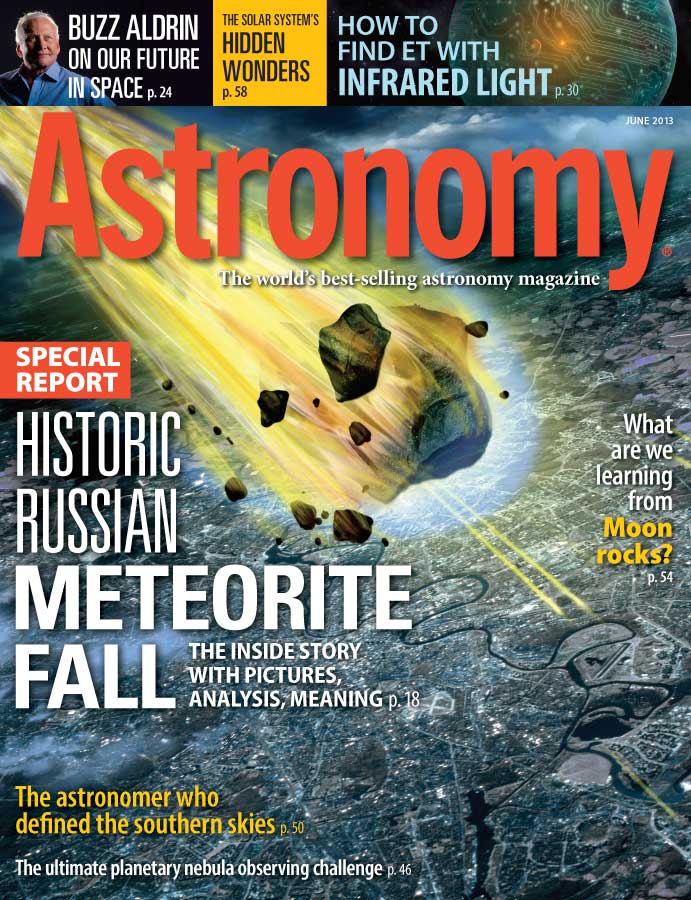
WAUKESHA, Wis. – February 15 was supposed to be all about a predicted asteroid flyby: 2012 DA14 would harmlessly whiz pass Earth closer than the orbits of many communications satellites and provide a new target for astronomers to study. And it did. But that wasn’t the news. Some 16 hours earlier, a different, unexpected asteroid entered our atmosphere and exploded some 76,400 feet (23,300 meters) above the Ural Mountains region of southern Russia.
The event left citizens of Earth reeling, as the shock wave that hit the ground shattered windows and collapsed buildings, ultimately injuring some 1,500 people. How did scientists not know about the asteroid? Where did it come from? Would there be a second impact, or was Earth now safe from such an occurrence for decades to come? The public needed answers, analysis.
In “2013’s historic Russian meteorite fall,” former NASA “rocket scientist” James Oberg addresses those questions and more. He explores what astronomers have learned about the asteroid since February 15 and clears up any misunderstandings that mainstream media might have inadvertently spread. Beyond that, though, Oberg discusses what such renewed concern over an impact will mean for future missions related to asteroid cataloging, warning systems, and planet defense.
To learn all about the February 15 impact and its effects, pick up the June issue of Astronomy, on newsstands April 30.
“Buzz Aldrin on our future in space”
Buzz Aldrin knows a thing or two about space exploration – after all, he was only the second person to set foot on the Moon. More than 40 years later, the noted astronaut remains a staunch supporter of humanity’s return to Earth’s natural satellite and eventually a move beyond that to Mars. In “Buzz Aldrin on our future in space,” he relives his experiences on the Moon, reflects on the current efforts for human spaceflight, and explores the options for getting back above low Earth orbit in the coming decades.
“Explore the ultimate planetary nebula catalog”
Planetary nebulae are stunning remnants of Sun-like stars that come in a variety of shapes and colors. But do you know those beyond the ones in Charles Messier’s catalog or the most famous in the NGC? In “Explore the ultimate planetary nebula catalog,” Senior Editor Michael E. Bakich introduces those unfamiliar with Luboš Kohoutek and Luboš Perek’s to the duo&’s exhaustive list of the 1,510 planetary nebulae discovered up to the end of the 20th century and challenges you to seek out as many as you can with your telescope. The hunt is on.
“What are we learning from Moon rocks?”
Have you ever wondered where the Moon rocks the Apollo astronauts brought back to Earth ended up? Today, most reside in safekeeping at the Lunar Sample Laboratory at Johnson Space Center in Houston, where specialists protect, preserve, and distribute samples for study. In “What are we learning from Moon rocks?” Meenakshi Wadhwa tours that facility and summarizes what its prized commodities have taught astronomers about Earth’s only natural satellite.
June sky events visible without optical aid
- June 1 – Mercury, Venus, and Jupiter line up in the evening twilight.
- June 11 – The Gamma Delphinid meteor shower peaks.
- June 12 – Mercury appears at its highest in the evening sky for Northern Hemisphere observers.
- June 23 – The largest Full Moon of 2013 occurs.
Also in the June 2013 Astronomy
- “How to find ET with infrared light” – The search for extraterrestrial intelligence has mostly revolved around radio signal detection, but such a civilization’s heat signature also could give away its location.
- “Bringing order to the southern skies” – Nicolas de Lacaille was a renowned astronomer in his day, but his most enduring influence lives on in constellations like Carina, Fornax, and Telescopium.
- “Discover our solar system’s hidden wonders” – Set up your telescope and target martian clouds, Saturn’s inner ring, a little-seen satellite of Jupiter, and more.
- “Vixen’s GPD2 mount tested” – This accessory features portability, superb craftsmanship, and high-quality tracking.
- “The Sky this Month” – Exclusive star charts will guide you through June’s night sky.
- The June issue of Astronomy also includes Astro News, Ask Astro, Breakthrough, Bob Berman’s Strange Universe, Stephen James O’Meara’s Secret Sky, Glenn Chaple’s Observing Basics, Tony Hallas’ Cosmic Imaging, Erika Rix’s Astro Sketching, Cosmic World, Letters, Web Talk, New Products, Reader Gallery, and Final Frontier.









